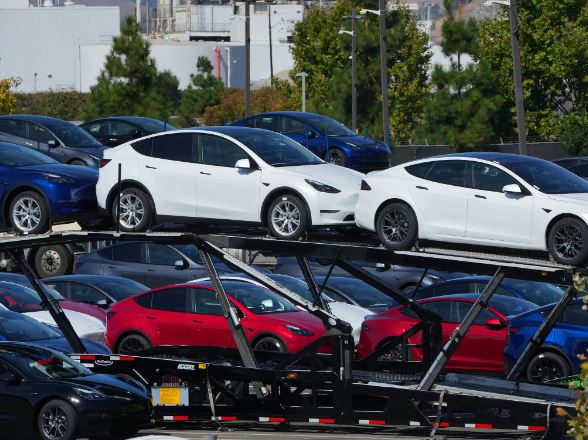Tesla witnessed a surge in sales during the final quarter of 2023, reaching 484,500 units, up from 435,000 in the preceding quarter and 405,000 in the same period in 2022. The increased sales were attributed to the carmaker’s strategic price cuts and heightened demand as customers rushed to capitalize on electric vehicle (EV) tax breaks. This uptick in sales is particularly noteworthy as Tesla faces intensifying competition from traditional automakers entering the EV market.
The company’s full-year sales amounted to 1.8 million vehicles, setting the stage for a potential 2024 milestone of surpassing two million units, positioning Tesla to potentially outpace established automakers such as Mercedes-Benz and Renault. The robust sales performance in the fourth quarter provides reassurance to investors who have been closely monitoring Tesla’s ability to maintain its dominant position in the evolving EV market.
Over the past year, Tesla has experienced a decline in market share, yielding ground to competitors like General Motors, Hyundai, Ford Motor, and Volkswagen as they introduced a broader range of electric vehicles. While Tesla still constitutes half of all electric cars sold in the United States, it lost some ground, dropping from a two-thirds market share in 2022.
Rivian, another player in the electric vehicle market, reported the sale of nearly 14,000 vehicles in the final quarter of 2023. Although this figure marked a substantial increase from the previous year, it represented a 10% decline from the third quarter.
In China, Tesla faces fierce competition from local automakers, particularly BYD, which outpaced Tesla by selling 526,000 fully electric cars globally in the fourth quarter. Chinese companies have been more agile in offering a diverse range of affordable electric models, catering to a broader consumer base beyond early adopters of technology.
Tesla has been actively wooing semiconductor firms in South Korea, Taiwan, and Japan to establish itself as a microchip hub in Indiana. However, the state’s plan to source substantial amounts of water for chip manufacturing from an aquifer raised environmental concerns and prompted a delay in the project. The increased scrutiny reflects the heightened tension over water resources as urban growth, industrial demands, and inconsistent regulations place strain on groundwater supplies.
In terms of global market dynamics, Tesla has been facing challenges, particularly in Europe, where Volkswagen and its Audi and Skoda divisions outsell Tesla in terms of electric vehicles. Notwithstanding this, the Tesla Model Y remains the top-selling model on the continent.
To boost sales before the end of the year, Tesla implemented price cuts, offering the Model 3 at reduced rates to benefit from federal tax credits. This move aimed to incentivize potential buyers who were eager to secure deliveries before the year-end, especially in light of new regulations designed to reduce China’s involvement in the supply chain.
While Tesla’s price reductions stimulated sales, they impacted profits, which fell by 44% in the third quarter compared to the previous year. The company is set to announce its earnings for the fourth quarter of 2023 on January 24.
As the landscape for electric vehicles evolves, with reduced federal tax credits for 2024, Tesla remains better positioned than many competitors. Certain Tesla models, such as the Performance version of the Model 3 and all versions of the Model Y, remain eligible for subsidies, as their batteries are manufactured domestically in collaboration with Panasonic.
In contrast, competitors like Ford face challenges, with their vehicles not qualifying for the federal tax credit in the new year. Ford and others rely on manufacturers in China for crucial components, and while Ford is constructing battery factories in the United States, production is not expected to commence until 2025.
General Motors has faced similar hurdles, with initial eligibility for tax credits limited to the Chevrolet Bolt. However, the company has expressed plans to adjust its supply chain to enable more models to qualify for tax credits in the coming year.
As the new year unfolds, Tesla and other automakers may benefit from lower interest rates, as investors anticipate central banks, including the Federal Reserve, adjusting rates amid cooling inflation.
The competitive landscape and regulatory environment will continue to shape the trajectory of electric vehicle sales, with Tesla navigating challenges and opportunities in this rapidly evolving market.

